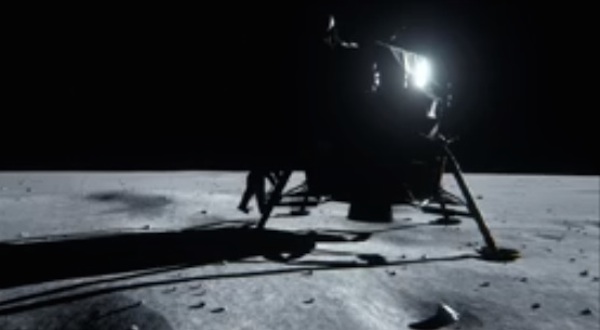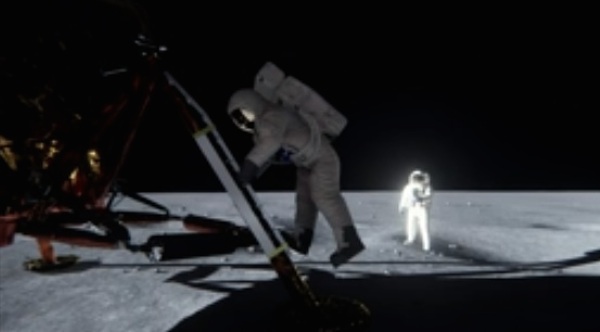.

Comparison of Nividia's rendering of Buzz Aldrin on lunar surface (left) and Neil Armstrong's original photo (right). (CREDIT: Nvidia)
.
Many conspiracy theorists who believe the Apollo moon landings were an elaborate ruse point to an iconic photograph of Buzz Aldrin that they claim could only have been taken using an artificial light source. Turns out they were right, but, as a new digital reconstruction of the Apollo 11 landing site by COMPUTER graphics chipmaker Nvidia proves, that artificial light source was not from a movie studio soundstage but Neil Armstrong’s spacesuit.




















Every epic moment in modern history inevitably spawns a tangled web of conspiracy THEORIES, and the Apollo moon landings are no exception. From the moment astronauts Neil Armstrong and Buzz Aldrin set foot on the lunar surface on July 21, 1969, some believed it was all an elaborate ruse STAGED by NASA on a Hollywood soundstage in spite of the overwhelming evidence to the contrary. (Of course, a different conspiracy camp believes man first landed on the moon a quarter-century before the Apollo astronauts when the Nazis established a top-secret lunar base where Adolf Hitler lived out his final years.)
Even the photographic evidence of the Apollo 11 astronauts on the moon has been seized by moon landing conspiracy theorists as proof of the hoax. In particular, they point to an iconic color photograph of Aldrin descending the LADDER of the lunar module Eagle. Since the sun was hidden behind the other side of the spacecraft, conspiracy theorists argue that Aldrin appears too brightly illuminated in the shadows for the picture to be real and that he could only have been so clearly photographed with the aid of artificial studio spotlights.
Now, computer graphics chipmaker Nvidia has employed its cutting-edge technology normally used to create realistic lighting in video games and movies to debunk one of the most persistent conspiracy theories in American history. “We wanted to take on the challenge of showing the single light source of the sun was actually able to light Buzz Aldrin even though he’s in the shadows,” MARK Daly, senior director of content development at Nvidia, said in a company video. Using Maxwell, the company’s new high-end graphics processing unit architecture that simulates the real-time properties of light, Nvidia engineers created a three-dimensional virtual lighting model of the Apollo 11 landing site.
To build its digital reconstruction, the project team studied satellite imagery of the Apollo 11 landing site as well as photographs and videos from the mission. They painstakingly RESEARCHED and measured the reflective properties of a range of materials from moon dust to the Eagle’s rivets to the fabric of the spacesuits.
Once the three-dimensional simulation was constructed, the engineers added in the sun as the sole light source and then integrated the reflected light from the lunar surface and spacecraft. However, they found the IMAGE still didn’t look quite right. “There was some additional light source that was just missing,” Daly said.
As it turns out, the conspiracy theorists were correct that an artificial light source illuminated the famous photograph of Aldrin. Only it wasn’t a studio light, but the man taking that photograph—Armstrong. “We found a clip of videotape that was shot from the other side of the LADDER,” Daly said. “There is a huge glowing bright white light. And as we analyzed that video a little more we realized it’s Neil Armstrong himself. The bright white spacesuit that he was wearing reflected all that sunlight off of him and back onto Buzz Aldrin so essentially Neil Armstrong himself was a light source in that scene.”
While moon dust reflects about 12 percent of the sun’s light, the spacesuits worn by the Apollo astronauts were virtual mirrors constructed of materials that reflected 85 percent of the light that struck them, and Armstrong was BATHED in full sunlight as he took Aldrin’s photograph. Once the Nvidia engineers adjusted for the reflectivity of Armstrong’s suit, the lighting in the virtual rendering nearly matched the actual photograph and proved that Aldrin could have appeared illuminated in the Eagle’s shadow with the sun as the sole lighting source.

An additional piece of photographic “evidence” cited by some conspiracy theorists is the absence of stars in the pitch-black sky in any of the Apollo photographs. Those who believe NASA faked the moon landing say the agency couldn’t realistically fabricate the position of the stars from various angles so they simply ignored them. The reason the stars aren’t visible in the photographs, however, is that the moon’s surface was so bright that the camera exposures were set to capture just the scene on the lunar surface. As the Nvidia model demonstrates, the stars would have been visible had the camera apertures been increased to let in more light. However, the historic scenes of Armstrong and Aldrin on the moon would have been completely washed out by the reflected light and never RECORDED, something that truly would have provided fodder for conspiracy theorists.
.
Frams:
.






Lichtsiumulation mit 3D-Computerprogramm








Reflexioneffekt durch Astronauten-Anzug


Apollo-11-Crew - Pressekonferenz nach Mondlandung

Sternenhimmel über Mond nur sichtbar bei Überbelichtung des eigentlichen Foto-Motives


Quelle:HISTORY
5116 Views
